
The new owners of the business that is right next door to my shop has not, to my knowledge, used their automatic irrigation system during the past two years. It shows. I installed the landscape for this storage company probably 14 years ago; the owners took great pride in the appearance of their business. As I cannot imagine that whomever owns this place now would want to pay what it would cost to replace the landscape, I choose to conclude that they have neglected to take charge of their clock. Their irrigation clock. I cannot imagine upon seeing these Annabelle hydrangeas, they would not run to the clock, and switch on the water.
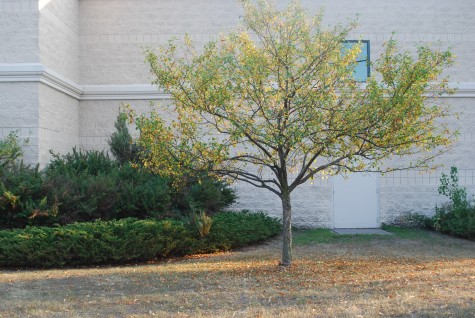
The landscape is in serious water distress. The crabapples are shedding leaves trying to stay alive by having fewer areas that are loosing water; I actually think the grass is dead. As I would rather write about a property owner who has a water problem they are trying to solve, I have a story. I do have a good client who lost three newly planted trees this spring; they drowned. It has been a process of trial and error to sort out the drainage issues from the irrigation problems. Upon engaging a new company to troubleshoot their irrigation system, numerous problems in the design and maintenance of the system became apparent. As an irrigation system is installed underground, you cannot spot the problems until they show up in the form of dying plants. Too much water can be as deadly as too little. Should you be so fortunate as to have in ground irrigation, you have a great tool within your grasp to provide water to you plants when they need it-without dragging the hose. The key-learning how to take charge and program your clock.
 My clients were fortunate to secure the services of a first rate irrigation company. When I say first rate, I mean there is a thoughtful and thorough person at the helm. He repaired all of the leaking pipes and heads. Then, he went to the clock. Most of what I will be covering regarding managing an irrigation system is paraphrased from what he took the time and trouble to explain to my clients. First and foremost-an irrigation system is not your big brother. It is a machine that needs to be programmed, depending on the season, the weather, and the types of plants you are watering.
My clients were fortunate to secure the services of a first rate irrigation company. When I say first rate, I mean there is a thoughtful and thorough person at the helm. He repaired all of the leaking pipes and heads. Then, he went to the clock. Most of what I will be covering regarding managing an irrigation system is paraphrased from what he took the time and trouble to explain to my clients. First and foremost-an irrigation system is not your big brother. It is a machine that needs to be programmed, depending on the season, the weather, and the types of plants you are watering.
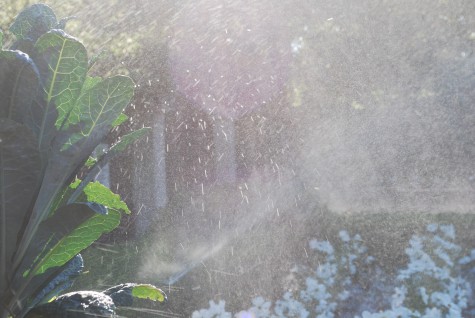 In the early spring, and in the later fall, when the temperatures are not above 60 degrees during the day, cut back on the water. When the weather is cool, the evaporation of water from the ground slows considerably; one a week watering is fine. Once the daytime temperatures go above 60, set your grass zones to run every other day for ten minutes. This is a benchmark that may work for you, or not-but it is a place to start. Grass in shadier spots where the evaporation rate is less, water less. Grass in full sun next to the asphalt pavement may need 12 minutes every other day. As grass can survive without water for 60 consecutive days, take the time to set the clock, and adjust the times if necessary. When it pours rain for two days, shut the machine off.
In the early spring, and in the later fall, when the temperatures are not above 60 degrees during the day, cut back on the water. When the weather is cool, the evaporation of water from the ground slows considerably; one a week watering is fine. Once the daytime temperatures go above 60, set your grass zones to run every other day for ten minutes. This is a benchmark that may work for you, or not-but it is a place to start. Grass in shadier spots where the evaporation rate is less, water less. Grass in full sun next to the asphalt pavement may need 12 minutes every other day. As grass can survive without water for 60 consecutive days, take the time to set the clock, and adjust the times if necessary. When it pours rain for two days, shut the machine off.
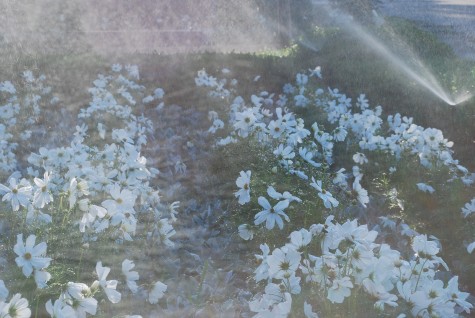 Shrub beds, trees, and established annuals need less water than grass. Check to be sure you lawn zone is not accidentally watering a shrub bed-that bed may be getting unneeded overlap from one zone to another that could damage those shrubs. Established trees and shrubs rarely need that much water, unless there is a drought-so resist the urge to water by rote. Always err on the dry side. If things look wilty, turn the time set to water on the clock up. If things look brown, turn the times way up. If things look saturated, or yellowish, turn the clock to the “Off” position. Automatic means just that-whether it is hot or cold, whether we have had 2 inches of rain yesterday, or no rain for a month, an irrigation machine will continue to water that the same time and rate as the last time you looked at your clock and set it.
Shrub beds, trees, and established annuals need less water than grass. Check to be sure you lawn zone is not accidentally watering a shrub bed-that bed may be getting unneeded overlap from one zone to another that could damage those shrubs. Established trees and shrubs rarely need that much water, unless there is a drought-so resist the urge to water by rote. Always err on the dry side. If things look wilty, turn the time set to water on the clock up. If things look brown, turn the times way up. If things look saturated, or yellowish, turn the clock to the “Off” position. Automatic means just that-whether it is hot or cold, whether we have had 2 inches of rain yesterday, or no rain for a month, an irrigation machine will continue to water that the same time and rate as the last time you looked at your clock and set it.
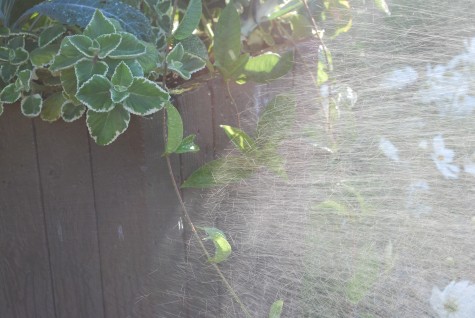 Taking 15 minutes a month to tune up your clock will save you countless hours and effort dragging a hose. Both Rob and Steve handwater everything-but their properties are small. I will say that though they have no automatic irrigation, both of their landscapes are happy and healthy. As I said, err on the side of too little.
Taking 15 minutes a month to tune up your clock will save you countless hours and effort dragging a hose. Both Rob and Steve handwater everything-but their properties are small. I will say that though they have no automatic irrigation, both of their landscapes are happy and healthy. As I said, err on the side of too little.
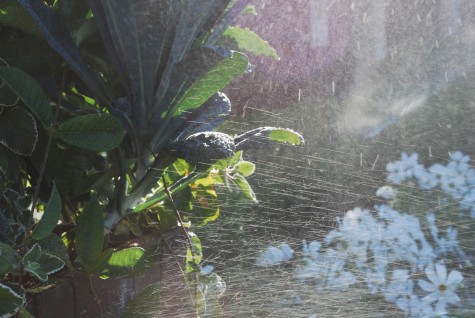 Automatic irrigation sends water into the air via a nozzle, or head, that is set to pop up once the irrigation goes on. Some nozzles that cover vast areas of lawn rotate as they spit out water. Smaller areas of shrubs or perennials may have nozzles called mist heads, that cover a much smaller area. Common to every nozzle is a flow rate. A good irrigation contractor will adjust the rate of flow of water after assessing all of your existing conditions. If you have zones that overlap, or zones in shade, you may want to reduce the flow. Less gallons per minute. But once your contractor has tuned up all of the mechanics to the best of his ability, thre responsibility for running that system will fall to the property owner.
Automatic irrigation sends water into the air via a nozzle, or head, that is set to pop up once the irrigation goes on. Some nozzles that cover vast areas of lawn rotate as they spit out water. Smaller areas of shrubs or perennials may have nozzles called mist heads, that cover a much smaller area. Common to every nozzle is a flow rate. A good irrigation contractor will adjust the rate of flow of water after assessing all of your existing conditions. If you have zones that overlap, or zones in shade, you may want to reduce the flow. Less gallons per minute. But once your contractor has tuned up all of the mechanics to the best of his ability, thre responsibility for running that system will fall to the property owner.
 Airborne water droplets evaporate quickly. You may use 100 gallons of water, of which only a percentage reaches the roots of the plants you are trying to water. For this reason, in ground irrigation is not designed to water new plants. Hand watering, that puts the water to the crown and roots is a necessity. A dusting of water over top a plant that has not yet sent out roots into the surrounding soil is not enough. New plantings need to be watched-and have your hand put to them. A babysitter will not do.
Airborne water droplets evaporate quickly. You may use 100 gallons of water, of which only a percentage reaches the roots of the plants you are trying to water. For this reason, in ground irrigation is not designed to water new plants. Hand watering, that puts the water to the crown and roots is a necessity. A dusting of water over top a plant that has not yet sent out roots into the surrounding soil is not enough. New plantings need to be watched-and have your hand put to them. A babysitter will not do.
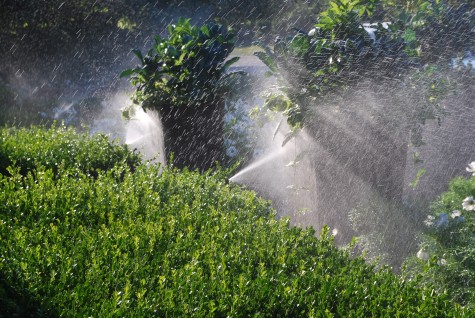 I will be the first to say that irrigation clocks were designed by some engineering type whose thought process is pretty much alien to my own. My clock is far too complex-just like my Suburban. I need forward, neutral, park, stop and go-I have 58 separate positions possible for the driver’s seat. This is vastly more than what I really need. I still have to call my irrigation person with questions about the clock. For certain, the one thing I have done that I find invaluable-a map of all the zones, and what they cover, pasted up next to the clock. I am only now learning how to change the duration of time on any zone given the percentage feature. When it is extremely hot-over 85 degrees, I up all the times on all the zones 140% to 200%. Ordinary summer hot, 85 degrees or less, I may water at 100%-130% of my normal time.
I will be the first to say that irrigation clocks were designed by some engineering type whose thought process is pretty much alien to my own. My clock is far too complex-just like my Suburban. I need forward, neutral, park, stop and go-I have 58 separate positions possible for the driver’s seat. This is vastly more than what I really need. I still have to call my irrigation person with questions about the clock. For certain, the one thing I have done that I find invaluable-a map of all the zones, and what they cover, pasted up next to the clock. I am only now learning how to change the duration of time on any zone given the percentage feature. When it is extremely hot-over 85 degrees, I up all the times on all the zones 140% to 200%. Ordinary summer hot, 85 degrees or less, I may water at 100%-130% of my normal time.
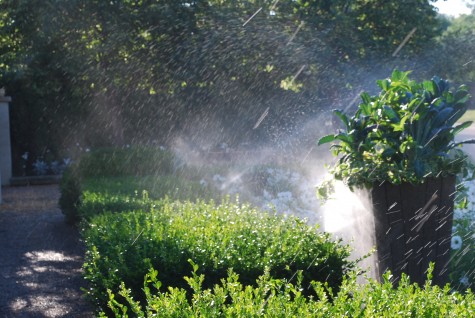
As I said first up, every bit of this came directly from, or is paraphrased from from Jack Linderman, who owns The Living Painting. Should you need some thoughtful help from an excellent irrigation contractor, I can recommend him. www.thelivingpainting.com.